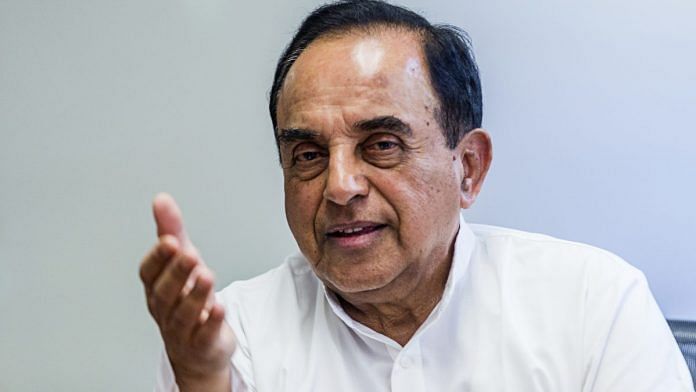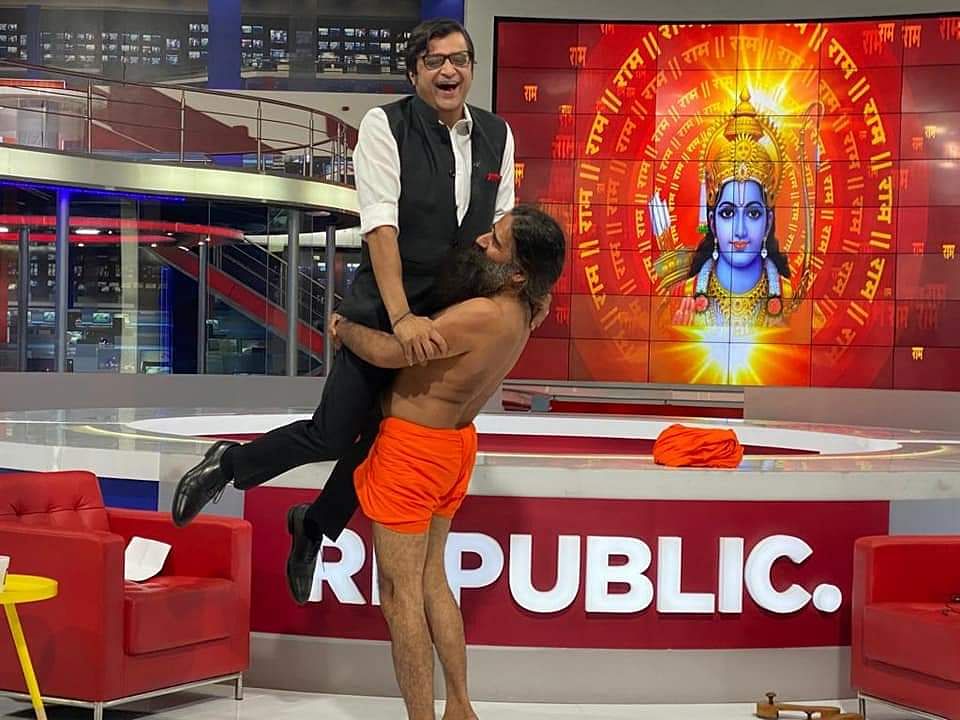
Prime Time
For television channels, Sunday was a mixed bag — Maharashtra, Ayodhya, the Kartarpur Corridor and air pollution— found space across channels.
The Ayodhya verdict dominated — Hindi news channels often resembled spiritual channels with bhajans and chants of “Jai Shree Ram”, “Ram Sita Ram” (ABP, News India 18).
In a “Super Exclusive” interview with Baba Ramdev, anchor Arnab Goswami practised yoga with him on Republic Bharat – Ramdev even lifted Goswami effortlessly off the floor. Looking for controversies even where none exist, Republic Bharat said the Supreme Court verdict had given Congress “stomach ache” — was Congress “Hindu-Virodhi” (against Hindus)? it asked.

Aaj Tak presented a 3D illustration of the proposed Ram temple and asked whether the temple would be ready by 2022.
By evening, politics asserted its primacy over Lord Ram with a “Mega twist” (Mirror Now) in the “Maha Showdown” (India Today) and a “Massive Times Now break — Sena agrees to NCP-Cong demand”. “BJP must back Sena”, advised Subramanian Swamy, BJP Rajya Sabha MP, “Ideology is Hindutva… don’t break it at any cost” (Republic).
Zee News: The channel claimed Shiv Sena had compared BJP to Hitler during a meeting of MLAs in Mumbai. “Maharashtra mein janata ki haar?” asked anchor Anki Tyagi.
Shiv Sena’s Kamlesh Rai looked aggrieved when he stated, “A partner should be treated as a partner — if you treat them like peon then no one will collaborate with you,” he said describing BJP’s attitude to Shiv Sena.
Political analyst Sanjeev Tiwari was more eloquent: “Dil se dil ka rishta hai… Par kuch log prem ke dhage ko todne mein lage hain. (BJP and Shiv Sena’s relationship is of the hearts, but certain ‘people’ want to destroy it.)”
ABP News: In “Karsevakpuram”, Hindu “mahants” replaced panelists, and ABP went from “Mandir wahi banayenge” to “Mandir jald banayenge” (as one of its panelists said).
However, there was some disagreement between the mahants: Karpatri Ji declared that the temple would be built within three months and Prime Minister Narendra Modi would inaugurate it. Mahant Atul Krishna Das said “Ram Janmabhoomi Nyas” would lead the proceedings as the saints who sacrificed their lives for the cause “cannot be ignored”.
Times Now: “India Upfront with Rahul Shivshankar” looked across the LoC: “Can Kartarpur bridge the divide?” it asked.
Sushant Sareen of the Observer Research Foundation said, “From the Pakistani point of view the intentions were never noble as far as Karatarpur is concerned.”
Kanwal Sibal, retired civil servant, explained why India went ahead with the Kartarpur Corridor: “Punjab is a border state & the sentiments of the Sikhs have to be respected”.
NDTV 24×7: On “We The People”, it was “Politics over Pollution” as anchor Sarah Jacob explored if there was a solution to pollution in Indian cities.
Jacob said, “We are sitting on ticking time bomb,” she said.
Aam Aadmi Party’s Raghav Chadha said he was “delighted to be a part of this debate as it addresses air pollution as a north-India problem… Every day, every year, every panel discussion is about Delhi, Delhi, Delhi… Air pollution does not understand state boundaries.”
Front Page
The political crisis in Maharashtra is the lead on the front page and on news channels, after the BJP said it was unable to secure a majority to form the government. The Ayodhya verdict also gets page 1 traction as newspapers focus on the implications of the historic judgment.
Maharashtra: The Times of India and The Indian Express have straightforward headlines— “BJP says it can’t form Maha govt, guv asks Sena if it can” (TOI) and “In Maharashtra , BJP says can’t form govt; Gov calls Shiv Sena” (Express). The Hindu and Hindustan Times frame it differently implying that BJP ‘chose’ not to form government in the state. “After BJP opts out, Governor invites Sena” reports Hindu, “‘Good luck to Sena’: BJP ditches bid to form govt” writes HT.
TOI writes that in a “swift response” caretaker chief minister Devendra Fadnavis informed the Maharashtra governor that “the BJP — the single largest party in the new assembly with 105 MLAs — did not have the numbers to prove a majority, putting the ball back in Shiv Sena’s court”. HT says BJP cited the Shiv Sena’s “insult to the mandate” as the reason for not being able to form government and “virtually challenged its pre-poll ally to stitch together a majority… after a fortnight of bickering over power-sharing in the state”.
In an accompanying report, Express reports that “within minutes” of the BJP informing the governor that it cannot form government, the “NCP laid down a set of conditions for backing a Shiv Sena-led ruling formation: Cut ties with BJP, quit NDA, evolve a common programme”.
Ayodhya verdict: Newspapers focus on various aspects of the verdict.
TOI traces the origins of the unanimous verdict — SC “veered towards a unanimous decision on the Ayodhya dispute soon after the arguments concluded on October 16”. It adds that the final verdict was ready by Thursday and the bench chose to announce the verdict Saturday after being informed that “adequate security arrangements had been put in place”.
The Hindu reports on national security advisor Ajit Doval’s meeting with Hindu and Muslim religious leaders Sunday to inform them of certain “hostile and anti-national elements” who may attempt to exploit the situation. HT writes “Hindu groups vied with each other to be part” of the central government’s trust while “a key Muslim outfit called a meeting on whether to accept the alternative plot”, it adds.
Express says the All India Muslim Personal Law Board (AIMPLB) will meet on 17 November to discuss if it should file a review petition.
T.N. Seshan: Former chief election commissioner (CEC) T.N. Seshan died Sunday at the age of 86. Express shows enterprise, with a Page 1 obituary by former CEC S.Y. Quraishi — Seshan’s demise “marks the end of a glorious era of resurgence of democracy about three decades ago”, he writes. The “very mention of his name was enough to put the fear of God in the hearts of recalcitrant politicians”, he adds.
TOI calls Seshan “the man who gave EC teeth” in its headline.
Others
HT and Express report that Chhattisgarh chief minister Bhupesh Baghel “formed a probe panel to investigate phone hacking complaints of Chhattisgarh-based rights activists” (HT). “The committee will also look into allegations that residents of the state have been subject to snooping,” and “suspicions’’ that NSO which owns the Pegasus spyware met the state police “two or three years ago”, adds Express.
The National Herald pulled down two opinion pieces on Ayodhya and apologised, Sunday, after massive criticism. One by Sujatha Anand, a columnist, “Why a devout Hindu will not pray at the Ram temple in Ayodhya” said he found it difficult to believe that “God can reside in a temple built by force, violence and bloodshed”.
The other by columnist Aakar Patel, compared the Supreme Court of India with Pakistan’s Supreme Court. Patel said the verdict was exactly what the BJP and VHP wanted.
Opinion
Hindustan Times: HT welcomes progress on the Kartarpur Corridor during a time of “heightened tensions” as“surprising and welcome” in “Kartarpur: a corridor of peace”. Pakistan PM Imran Khan used the inauguration to make a “fresh plea” to resolve Kashmir’s issues, but “without raking up fears of nuclear exchange”. Negotiations look unlikely until Pakistan acts against “the numerous United Nations-designated terrorist leaders and groups” that operate from its territory. The Indian government will “continue to eye the corridor with caution”, and look out for pro-Khalistan elements.
The Hindu: The Supreme Court’s Ayodhya verdict is indicative of a path “most conducive to social harmony”. But the allotment of 5 acres to Muslim litigants is “more of moral consolation by way of a political compromise” and less of recognition of their religious rights, says Hindu. The court’s unanimity and resolve to bury a politically divisive issue is welcome, but the “bitter truth” is that there was a fear of “Hindu backlash” if there was an adverse verdict. After the political communalisation, violence and destruction caused by the dispute, the temple movement and BJP’s infamous ‘rath yatra’, a “real sense of justice” would mean those behind the demolition of Babri Masjid are convicted, and the VHP and other similar organisations are excluded from the new temple trust.

COMMENTS